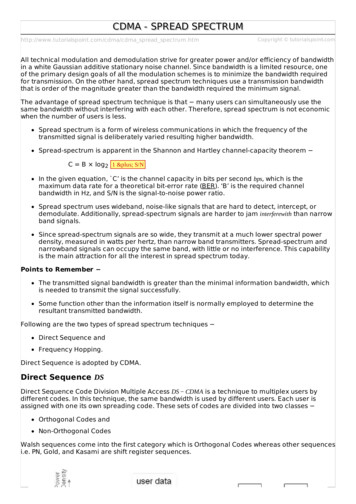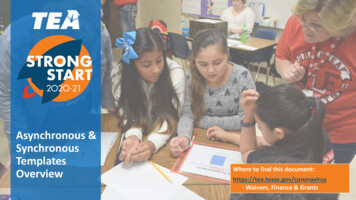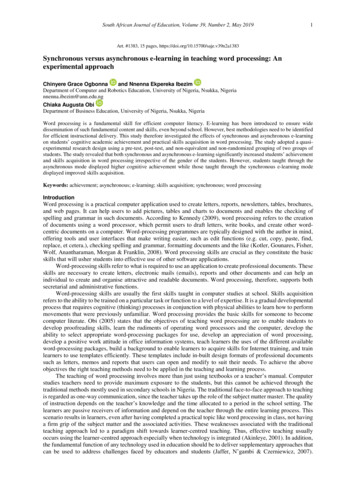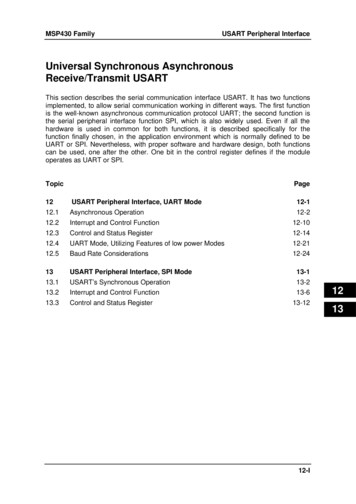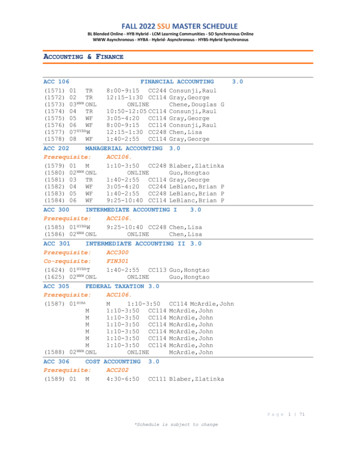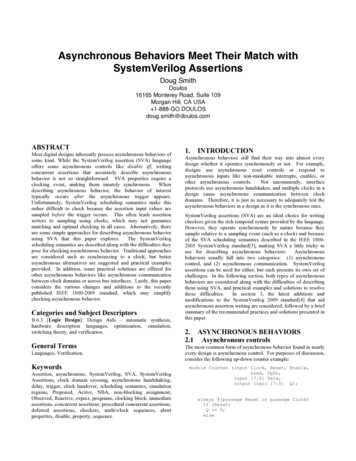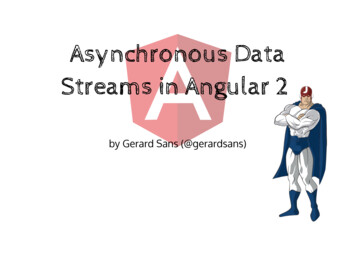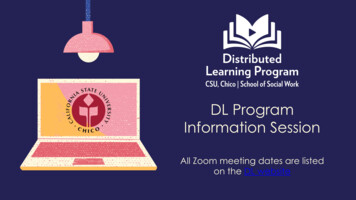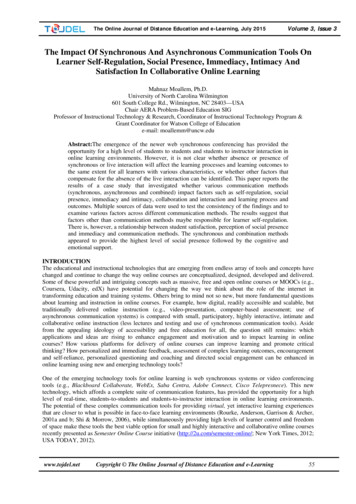
Transcription
Open Praxis, vol. 8 issue 1, January–March 2016, pp. 21–39(ISSN 2304-070X)Synchronous and Asynchronous E-Language Learning:A Case Study of Virtual University of PakistanAyesha PerveenVirtual University of Pakistan (Pakistan)ayesha@vu.edu.pkAbstractThis case study evaluated the impact of synchronous and asynchronous E-Language Learning activities(ELL-tivities) in an E-Language Learning Environment (ELLE) at Virtual University of Pakistan. The purposeof the study was to assess e-language learning analytics based on the constructivist approach of collaborativeconstruction of knowledge. The courses selected for random sampling were English Comprehension (Eng101),Business & Technical English (Eng201) and Business Communication (Eng301). Three methods wereemployed to collect the data: observation of the communication and performance on given channels, students’opinions on Graded Discussion Board (GDB), and a survey questionnaire. Out of a total population of 9919,1025 responses were received for the survey questionnaire. The findings revealed that asynchronouse-language learning was quite beneficial for second language (L2) learners, but with some limitations whichcould be scaffolded by synchronous sessions. Based on the findings, the researcher suggested a blendof both synchronous and asynchronous paradigms to create an ideal environment for e-language learningin Pakistan.Keywords: E-Language Learning Environment, E-Language Learning activities, constructivism, asynchronouscommunication, synchronous communication, second language learningIntroductionWe shape our tools, and thereafter our tools shape us (McLuhan, 1995, p. ix)Online learning environments can be divided into a triad of synchronous, asynchronous and hybridlearning environments. Synchronous learning environments provide real time interaction, which canbe collaborative in nature incorporating e-tivities (Salmon, 2013) such as an instructor’s lecture witha facility of questions-answer session. However, a synchronous session requires simultaneousstudent-teacher presence. On the other hand, asynchronous environments are not time bound andstudents can work on e-tivities on their own pace. A hybrid online environment blends synchronoussessions with asynchronous set of e-tivities. It can be called hybrid as it combines simultaneity withnon-simultaneity as instructional design for both synchronous and asynchronous teaching may havealtogether different patterns. A study by Karen Swan (2001) maps learners’ satisfaction and perceivedlearning in an asynchronous mode. She finds clarity of design, interaction with instructors, and activediscussions among course participants as key factors of students’ satisfaction and perceivedlearning. Mc Brien, Cheng and Jones (2009) analyze the impact of synchronous sessions onstudents’ learning and find it a good way of reducing distance in distance education. It is importantto know how students perceive their learning behavior in both media (Somenarain, Akkaraju &Gharbaran, 2010). Based on students’ perceptions and learning analytics (Greller & Drachsler,2012), this paper discusses the strengths and weaknesses of the two paradigms in general andwith reference to English language learning/teaching in particular. The case study in this regard isVirtual University of Pakistan (VUP), with its twelve years of e-learning experience.Reception date: 30 April 2015 Acceptance date: 23 December 2015DOI: http://dx.doi.org/10.5944/openpraxis.8.1.212
22Ayesha PerveenAsynchronous E-LearningAn asynchronous mode of learning/teaching has been the most prevalent form of online teachingso far because of its flexible modus operandi (Hrastinski, 2008). Asynchronous environments providestudents with readily available material in the form of audio/video lectures, handouts, articles andpower point presentations. This material is accessible anytime anywhere via Learning ManagementSystem (LMS) or other channels of the sort. LMS is a set of tools that houses course content andprovides a framework for communication between students and teachers like a classroom. Otherterms sometimes used instead of LMS are Course Management System (CMS) and Virtual LearningEnvironment (VLE). CMS is comparatively an older term and its usage is less common today as itimplies basic management of course content, while LMS indicates the system that supports thelearning process. The term VLE also implies the support of the learning process, but it is morefrequently used to describe systems that support blended learning environment (Watson, Gemin,Ryan & Wicks, 2009). Some institutions develop their own LMS; others either utilize an open sourceor purchase an LMS. The case study in this paper, Virtual University of Pakistan, has developedits own LMS to provide a virtual learning environment to students.Asynchronous e-learning is the most adopted method for online education (Parsad & Lewis, 2008)because learners are not time bound and can respond at their leisure. The opportunity of delayedresponse allows them to use their higher order learning skills as they can keep thinking about aproblem for an extended time period and may develop divergent thinking. The spontaneity ofexpression is replaced by a constructed response. Therefore, asynchronous space leads to a selfpaced, independent, student-centered learning (Murphy, Rodríguez-Manzanares & Barbour, 2011).Hence, asynchronous e-learning can scaffold students’ previous knowledge with new concepts (Lin,Hong & Lawrenz, 2012). Less reliance on memory and notes and more opportunity of discussionswith peer groups help build critical thinking and deep learning (Huang & Hsiao, 2012). Shyness isreduced due to the distance mode, which alleviates the fear of the teacher. As there is less pressurethan a real time encounter, the affective filter remains low and learners can respond more innovativelyand creatively. The chances of getting irritated by technological problems—like low speed andnon-connectivity—are the least, as ample time to attempt e-tivities is available.Asynchronous e-learning can be challenging as only a carefully devised set of strategies can keepstudents engaged and interested in this sort of learning environment to facilitate motivation,confidence, participation, problem solving, analytical and higher order thinking skills. Moreover, it isa self-paced system in which the students have to be self-disciplined to keep themselves active aswell as interactive to keep track of e-tivities. Whereas discussions on forums and blogs can keepthem active, going off topics can also distract them. Delayed feedback can be another frustratingfactor (Huang & Hsiao, 2012). Moreover, there are insufficient opportunities for socializing andstudents have to look for ways of networking themselves.Synchronous E-LearningSynchronous e-learning, on the other hand, refers to learning/teaching that takes place simultaneouslyvia an electronic mode. Synchronous voice or text chat rooms provide an opportunity of teacherstudent and student-student interaction. Apart from chat, video-conferencing facilitates face-to-facecommunication. Web conferences through surveys, polls and question-answer sessions can turnout to be more interactive than video conferencing.Synchronous mode instills a sense of community through collaborative learning (Teng, Chen,Kinshuk & Leo, 2012; Asoodar, Atai, Vaezi & Marandi, 2014). A synchronous virtual classroom is aplace for instructors and students to interact and collaborate in real time. Using webcams and classOpen Praxis, vol. 8 issue 1, January–March 2016, pp. 21–39
Synchronous and Asynchronous E-Language Learning: A Case Study of Virtual University of Pakistan23discussion features, it resembles the traditional classroom, except that all participants access itremotely via the Internet. Lessons can be recorded and added to an e-library. Using the archivede-library, students can access and replay teacher’s lectures as many times as necessary to masterthe material. Direct interaction with teachers and students in real time is very much like a traditionalface-to-face classroom, rather better, as distance is no more a barrier and by connectivity via theInternet no time is wasted in traveling. etc. Synchronous sessions can result in high levels ofmotivation to stay engaged in e-tivities due to teacher and class-fellows presence (Yamagata-Lynch,2014). Instant feedback and answers can help students resolve any problems they encounter inlearning. Facial expressions and tones of voice can aid them to have the human feel at a broaderspectrum and lead to global interaction without much cost.Some of the challenges of synchronous education can be the need of the availability of studentsat a given time and the necessary availability of a good bandwidth Internet. Participants can feelfrustrated and thwarted due to technical problems. In addition, a carefully devised instructionaldesign is required as pedagogy is more important than technologically facilitated media. For example,Murphy et al. (2011) consider synchronous mode more teacher-oriented. Special e-tivities need tobe created to broaden the scope of synchronous communication from a lecture or teacher-studentdiscussion only.Language Learning in Asynchronous and Synchronous ModesBroadly speaking, effective learning refers to strengthening the relationship between learningprocesses of collaboration, interaction, participation and responsibility, and learning objectives andoutcomes like problem solving skills, critical thinking and higher order thinking (Watkins, Carnell,Lodge & Whalley, 1996). Therefore, the design and implementation of any e-language learningpedagogy should provide maximum support to students for achieving objectives and outcomes toavoid frustration (McCloskey, Thrush, Wilson-Patton & Kleskova, 2013), especially in comparisonto traditional face-to face language learning process which provides a real time interaction, immediatefeedback and a feel of human touch. This can be achieved by creating a context of language learningthrough collaboration as a communicative approach of language teaching to encourage groupe-tivities and social construction of language through interaction with a shift of focus from teachercentered pedagogy to learner autonomy (Borg & Al-Busaidi, 2012). The researcher has coined anew term ‘Elltivity’ (E-language learning activity) for any e-tivity devised for an online languageclassroom in general and second language (L2) classroom in particular.Online learning facilitates a multiplicity of language learning styles. A community of inquiry model(Garrison, Anderson & Archer, 1999) with a teacher, cognitive and social presence can be a greataid to both a/synchronous language learning. A conversational framework for direct communication(Laurrilard, 2013) based on question-answer mode and direct feedback from teacher can befacilitated through synchronous mode. However, a teacher’s observation is not sufficient unless weget to know how learners wish to learn what they want to learn (West, 1994). Therefore, the firststep in designing any language course is students’ needs analysis (Johns, 1991). The needs analysisshould be pedagogic (West, 1994) as well as psychological and social (Seedhouse, 1995) to achievesuccessful communication in a target situation (Chambers, 1980). With reference to online learning,students must be aware about the environment in which they learn a language. Students’ comfortwith synchronous and asynchronous E-Language Learning Environments (ELLE) is importantbecause the language learning styles and strategies as well as teaching methods that work well inone paradigm may not be equally fruitful in the other (Dudley-Evan & St Jones, 1998). Onlinelanguage teachers should strive to design environmentally sensitive courses (Jordan, 1997), whichOpen Praxis, vol. 8 issue 1, January–March 2016, pp. 21–39
24Ayesha Perveencan lead to a carefully devised instructional design based on technological pedagogic contentknowledge (Koehler & Mishra, 2005). Technological pedagogical content design is a time takingprocess, as it needs a deep understanding of the relationship between content, pedagogy, technologyand the context where it would be operational (Koehler, Mishra & Yahya, 2007). A careful analysisof the perception of language learners about the environment they learn language in and the contextit creates for them is significant for facilitating them with a better ELLE.Asynchronous e-language learning facilitates students from myriad backgrounds and differentlevels of L2 skills to formulate syntactically and semantically correct sentences by writing andre-writing them for either writing emails or posting discussion comments. This provides them anopportunity of revising their sentences for correctness. The peer pressure of their questions/comments being openly available to be read by their fellow students and teachers helps them workon better formulations of statements. The answers help develop understanding of the concepts(McLoughlin & Lee, 2010a). Moreover, they have ample time to attempt Elltivities, revise their textsor even seek guidance about their writings before uploading them.Synchronous e-language learning allows them to listen to their teachers providing them anexposure to native/non-native listening input. Simultaneously they get direct feedback for their erroranalysis, which can lead to conscious language learning or meta-learning. Written presentations bythe teacher provide necessary pressure to read and comprehend immediately, as well as writing inchat box leads to immediate construction of sentences to be monitored by the teacher or fellowstudents. As learner anxiety can have adverse effect on L2 learning progress, learners’ emotionalbehavior must be kept in mind while designing Elltivities for a synchronous session (Chen & Lee,2011).Establishing the current practices of synchronous and asynchronous e-learning/teaching in Englishlanguage, this study evaluates the effectiveness of a/synchronous environments towards betterEnglish language learning at Virtual University of Pakistan (VUP). There are three choices: first, thecontinuation of the asynchronous model; second, switching to a totally synchronous model, andthird, to strive towards a perfect blend of the two. Researches show that learners often prefer ablend of a/synchronous e-language learning (Pérez, 2013), as it can better cater their multiple needsand facilitate in enhancing their capabilities to learn L1 or L2. VUP has been using asynchronousmodel for language teaching since its inception. The synchronous mode was introduced in 2013and this paper evaluates the strengths and weaknesses of a/synchronous contexts for Englishlanguage teaching/learning.This paper aims to address the following research questions:Q1.Q2.Q3.What is the perception of language learners about different a/synchronous Elltivities usedin a virtual learning environment?Do asynchronous Elltivities facilitate language learning or hinder the process?Can an asynchronous pedagogical model be totally replaced by a synchronous model ora blend of the two better facilitates language learning?Literature ReviewTeaching presence must be as concerned with cognitive development as with a positive learning environment, and it must see content, cognition, and context as integral parts of the whole (Garrison & Anderson,2003, p. 69)Innovations in electronic or virtual learning have also affected language learning and teaching(Martín-Blas & Serrano-Fernández, 2009). Second Language Acquisition (SLA) is a multifacetedOpen Praxis, vol. 8 issue 1, January–March 2016, pp. 21–39
Synchronous and Asynchronous E-Language Learning: A Case Study of Virtual University of Pakistan25process that occurs spontaneously in communicative situations. SLA is generally considered aconscious, knowledge-accumulating process that usually takes place through formal education(Bialystok & Hakuta, 1999). Online learning can be an ideal medium for language learning becauseof its potential to utilize multiple teaching methods, strategies and learning styles.Howard Gardner (2011) challenges any educational system that provides same pedagogicaldesign, i.e., same content and method of teaching to all students. Students have multiple intelligences.Each may have a different cognitive approach to learning and the learning style may vary fromvisual-spatial to kinesthetic, musical to interpersonal or intrapersonal and linguistic to logicalmathematical (Gardner, 2011). To cater multiple and unique learning styles of students, a pedagogyof multiliteracy is required (Guth & Helm, 2012). Online learning environments provide a room formultiliteracy because of multiple ways of communication through multiple media connected to amultiple world in a multiple ways (Stein & Newfield, 2006). This expanding landscape of learning isall the more important for English language learning, which has gained the status of an internationalor global language (Crystal, 2012), because online learning provides a global context for teachingEnglish as a second language (TESL). ELLE has the potential to move from Grammar Translationto Audio-lingual methods or from The Silent Way and Suggestopedia to The Communicative Way(Larsen-Freeman & Anderson, 2013). The potential to utilize them all leads to a principled eclecticapproach (Mellow, 2002), which is pluralistic in nature leading to the timely use of any method basedon needs analysis.Asynchronous e-learning can incorporate all L2 teaching methods that allow for delayed feedbackand delayed response as in emails and discussion boards. Asynchronous language learning canbe more encouraging for learners to ask questions that require long answers (AbuSeileek &Qatawneh, 2013). Written nature of communication allows greater opportunity to reflect and expressideas more freely than in face-to-face oral communication. Learners get ample time to reflect onother students’ language expression and can compose their own by careful design and improvementfor precision. Written exchange of communication can also be useful for those students who do notactively participate in written discussions and remain passive readers. Forum discussions can behelpful in discourse development for timid students due to the anonymity of identity (Maclntyre,Clément, Dörnyei & Noels, 1988). However, asynchronous mode has its disadvantages in reducingdirect feedback and immediate interaction.Synchronous language learning is closer to the communicative way of language teaching/learningwith whiteboards, video chat or voice chat providing immediate feedback to help students improvetheir language skills. Thus, it can duplicate the face-to-face real time classroom (Keegan et al.,2005). The familiarity of the classroom model, immediate feedback from teacher and fellow studentsand creating contents quickly in the classroom are the hallmarks of a synchronous languagelearning environment. Synchronous net-based discourses can improve understanding of complexsubject matters (Pfister, 2005) and, as a result, non-native English speakers can outperform faceto-face language. However, it can be problematic for students due to being time bound and theavailability of technology on a scheduled time.Both a/synchronous modes can be beneficial for language learning (Pérez, 2013). A blend of thetwo models can give students an opportunity to better learn than any of the individual models. A/synchronous modes can complement each other in teaching/learning language through theconversational framework (Laurillard, 2007) and constructivist approaches of creating meaningthrough dialogue, reflection and experience (Reynolds, Wang & Poor, 2002). When blended, theycan provide a wonderful model for enhancing language learners’ cognitive participation, informationprocessing and motivation (Ge, 2011). Language learning is more of a skill-oriented process ratherthan content mastery. To develop listening and speaking skills, recurrent synchronous sessions areOpen Praxis, vol. 8 issue 1, January–March 2016, pp. 21–39
26Ayesha Perveenrequired (Wang & Chen, 2009). As most of online students work and study simultaneously,asynchronous mode is more appropriate (Mcloughlin & Lee, 2010b) to avoid anxiety resultingfrom being time bound in synchronous sessions (Guichon, 2010). Most of the studies related toa/synchronous media have explored students’ performance and level of engagement so far; however,the context of learning is mostly ignored, especially with reference to EFL/ ESL learners (Yang,2011). It is important to learn students’ perceptions about the impact of synchronous andasynchronous sessions on their behavior to improve online learner-centered language pedagogy(Sun, 2011).MethodTo evaluate the effectiveness of asynchronous mode, three methods were used to triangulate data:first, the overall observation of the participation of a/synchronous Elltivities in Fall 2013 semester;second, the collection of students’ opinions via a structured questionnaire about a/synchronousmodes for learning language; and third, their discussion about the preference of a/synchronousmodes on the Graded Discussion Board (GDB).The usual mode of Elltivities in VUP remained asynchronous with students’-instructorscommunication via emails, Moderated Discussion Board (MDB); and their assessment was basedon Elltivities through assignments, GDB and exams (Figure 1).Participants in this study consisted of three classes at VUP: English Comprehension (Eng101),Business and Technical English (Eng201) and Business Communication (Eng301). The observationof communication and performance lasted for one semester (Fall 2013) of approximately 5 months.To conduct this study two synchronous sessions were conducted in all three courses, one beforethe midterm and the other one after the midterm. The number of active students in Eng 101 was(N 4248), in Eng 201 (N 3906) and in Eng 301 (N 1765). Although the study is qualitative, asmuch data as possible was collected via a survey questionnaire and opinions of the students postedon Graded Discussion Board (GDB) for an in-depth understanding (Polkinghorne, 2005). As a result,1816 opinions in Eng 101, 1993 in Eng 201 and 816 in Eng 301 were posted on GDB, which makesa total of 4625 posts out of the total population mentioned above.To reinforce the observations of the researcher about students’ response to a/synchronousElltivities, a survey was conducted via a questionnaire that was filled by (N 1025) students from allover Pakistan. The question items were developed based on the researcher’s observation ofE-Language Learning Environment (ELLE). The questionnaire consisted of 20 questions; both openand close-ended questions were included in the survey to gain maximum insight about students’experiences in ELLE. The questionnaire data was collected over the semester. The respondents’response was overwhelming.Demographic Details of the SampleThe demographic details of the students were collected in the first five questions. The first questionidentified gender. The total number of participants in the questionnaire was 1025, out of which 644-i.e. 64%- were male and 362 -i.e. 36%- were female. The second question helped gather dataabout the age group of students. 854 students -i.e. 84%- were 17–30 years and 138 -i.e. 14%- were31–40 years. Most of the active students belonged to the 17–30 years age group i.e., young adults.The third question collected details about the province they belonged to. 78% of the students werefrom Punjab and 9% (n 93) from Sindh. Question four collected data about their academicqualification. A total of 53% were bachelor degree holders, 23% Master degree holders, 23%Open Praxis, vol. 8 issue 1, January–March 2016, pp. 21–39
Synchronous and Asynchronous E-Language Learning: A Case Study of Virtual University of Pakistan27Figure 1: A/synchronous ELLE at VUPIntermediate, 4 MS and 1 PhD. The findings revealed that majority of respondents had completedbachelors. The fifth question referred to the working/non-working status of students. 387 participants-i.e. 41%- were almost always and currently employed, 29% (n 279) were almost always unemployed,and 21% (n 200) were occasionally employed. So most of the enrolled students were employed.Open Praxis, vol. 8 issue 1, January–March 2016, pp. 21–39
28Ayesha PerveenResultsThe major focus of the questionnaire was to collect students’ opinion about the usefulness ofa/synchronous modes for English language learning based on their experiences in the semesterFall 2013. Following is the description of their responses.Awareness about A/Synchronous E-Language LearningQuestions 6 and 7 referred to students’ awareness about a/synchronous e-language learning.Figure 2: Awareness about a/synchronous e-learningThe visual graphics in Figure 2 show that 630 participants -i.e. 62%- were aware about asynchronouse-learning whereas 380 -i.e. 37%- were not aware of the term asynchronous e-learning, and 640participants -i.e. 64%- were aware about synchronous e-learning whereas 358 -i.e. 36%- were notfamiliar with the term synchronous e-learning.A total of 64% and 62% of participants were well aware of synchronous and asynchronous modesof language learning respectively.English Language Learning in A/Synchronous ModesQuestions 8 and 9 were close-ended question seeking participants’ opinion whether English languagecould be better learnt a/synchronously or not.Open Praxis, vol. 8 issue 1, January–March 2016, pp. 21–39
Synchronous and Asynchronous E-Language Learning: A Case Study of Virtual University of Pakistan29Figure 3: Is a/synchronous mode better for ELT?578 participants -i.e. 57%- were positive about asynchronous e-language learning whereas 429 -i.e.43%- were not in favor of asynchronous e-learning (Figure 3). 824 participants -i.e. 82%- were infavor of synchronous mode of language learning whereas 182 -i.e. 18%- were not in its favor.Desirable Duration of a Synchronous SessionAlready one-hour synchronous sessions were conducted during the semester, so the students wereasked in the next question about the desirable duration of the session. Four options were given inthis regard: 20, 30, 40 and 50 minutes.Figure 4: Duration of a synchronous sessionFigure 4 shows that 343 -i.e. 33%- were in favor of a 30 minutes synchronous session; 255 -i.e.25%- were in favor of a 40 minute session and 199 -i.e. 19%- were in favor of a 20 minute session.The results show that most of the participants were in favor of a 30 minutes session.Open Praxis, vol. 8 issue 1, January–March 2016, pp. 21–39
30Ayesha PerveenMost Helpful Asynchronous Activity for Language LearningQuestion 11 asked about the most helpful activity in asynchronous mode of language learning.‘Email’, ‘GDB’, ‘MDB’, ‘Quiz’ and ‘assignments’ options were given, along with ‘all of the above’ and‘none of the above’ options. They were also given the option to give any other comments. Theresults are given in Figure 5:Figure 5: The most helpful activity in asynchronous e-language learningA total of 572 participants -i.e. 56%- found all Elltivities to be helpful in asynchronous languagelearning whereas 129 -i.e. 13%- found assignments as the most helpful activity in asynchronousmode.Active Participation in a Synchronous SessionQuestion 12 asked about students’ active participation in synchronous sessions.Figure 6: Active participation in a synchronous sessionOpen Praxis, vol. 8 issue 1, January–March 2016, pp. 21–39
Synchronous and Asynchronous E-Language Learning: A Case Study of Virtual University of Pakistan31Figure 6 shows that 67% (n 691) did not participate in the synchronous activity and 33% (n 334)participated in it. So most participants did not attend the synchronous sessions.Question 13 asked whether synchronous activities helped them improve their English and 62%agreed whereas 38% disagreed (Figure 7).Figure 7: Synchronous sessions helped in improving EnglishStrengths and Weaknesses of Asynchronous E-Language LearningQuestion 14 sought participants’ opinion about the strongest point of asynchronous e-languagelearning. They were given the options of ‘not time bound’, ‘not place bound’, ‘allows time to reflect’,‘written responses’ and they could choose all or none of the above, as well as give any additionalremarks.Figure 8: The strongest features of asynchronous e-language learningOpen Praxis, vol. 8 issue 1, January–March 2016, pp. 21–39
32Ayesha PerveenFigure 8 shows the description of the strongest points of asynchronous e-language learning.A total of 567 participants -i.e. 55%- considered all options as the strong points of asynchronouse-language learning and 199 -i.e. 19%- pointed out that the best aspect was that asynchronouse-language learning was ‘not time bound’.The greatest weakness of asynchronous language learning was explored by question 15. Apartfrom all of the above, none of the above and any other, the options given were ‘no face to faceinteraction with the teacher’ and ‘no simultaneous answers’. The results are shown in Figure 9.Figure 9: The greatest weakness of asynchronous e-language learning43% chose ‘all of the above’ option whereas 34% considered ‘no face to face interaction withteacher’ as the greatest weakness.Strengths and Weaknesses of Synchronous E-Language LearningQuestion 16 asked about the greatest strength of synchronous e-language learning (Figure 10).Figure 10: The greatest strength of synchronous e-language learningOpen Praxis, vol. 8 issue 1, January–March 2016, pp. 21–39
Synchronous and Asynchronous E-Language Learning: A Case Study of Virtual University of Pakistan3350% participants (n 510) found all aspects as strengths of synchronous e-language learning and28% (n 153) were in favor of face-to-face interaction with teacher as the greatest strength.The students were asked about the greatest weakness of synchronous e-language learning inthe nex
2014). Instant feedback and answers can help students resolve any problems they encounter in learning. Facial expressions and tones of voice can aid them to have the human feel at a broader spectrum and lead to global interaction without much cost. Some of the challenges of synchronous education can be the need of the availability of students
